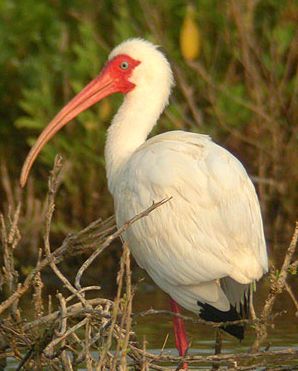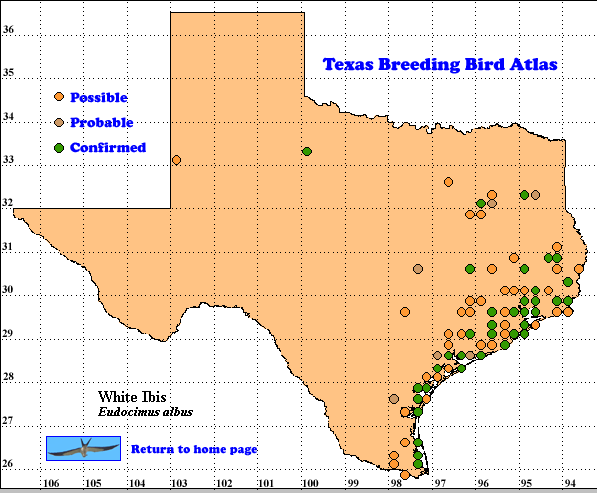Adult White Ibises feed mostly on fiddler crabs that are obtained in brackish waters of estuarine habitats. However, salt toxicity prevents their nestlings from developing normally on brackish-water prey because their salt- excreting glands are not yet fully developed; so, the adults fly inland to freshwater habitats and obtain crayfish for their nestlings (Kushlan and Bildstein 1992, Bildstein 1993). Although their coastal breeding colonies are protected, their inland feeding areas are subject to rapid human development. Thus, they cannot sustain their populations without both habitats.
In Texas, an important influence on waterbird populations is the 20-25 year precipitation cycle (Telfair 2002). Between the early 1960s and late 1980s, there was a significant upward trend in the cycle; since then, the trend has begun to decrease (Tom Spencer, Texas Forest Service, pers. comm.). The trend varies regionally and there are intermittent drought years and irregular intervals with pronounced wet/dry springs-summers such as those associated with El Niño/La Niña years and massive slow-moving atmospheric disturbances (Dr. Robert K. Peters, NWS Observer for Tyler, Texas, pers. comm.). Inland wetland habitats are particularly subject to the effects of these trends. Unfortunately, various census techniques were used between 1959-1973 and the data collected during those years are not readily comparable and are not comprehensive. Thus, the possible relationship between White Ibis breeding populations and the precipitation cycle are unknown for earlier years.
The decurved beaks of White Ibises, their black and white wing color pattern in flight, and coastal breeding habitat allow them to be easily distinguished from white egrets. Therefore, censuses of them are probably fairly accurate.
DISTRIBUTION: The White Ibis is a common to abundant resident along the coast and Coastal Prairies. Oberholser (1974) reported White Ibises bred inland, but not far from the coastal region (Victoria County 1930, Fort Bend County 1939, and Liberty County 1972). Since 1959,White Ibises have expanded their breeding range inland to include scattered locations in the eastern third of the state, most notably in the southeast, central and north- central areas (Waller in Waller County 1959-1961 (no census), Beaver-Catfish Hunting and Fishing Club in Anderson County 1971-1979 (1-30 pairs), Gus Engeling Wildlife Management Area 1986 (80 pairs), Ennis in Ellis County 1973 (1 pair), Eagle Lake in Colorado County 1976 (10 pairs), Washington County 1999 (no location, no census), Southwestern Medical Center at Dallas in Dallas County 2005 (5 pairs), 2006 (7 pairs), and Robinson in McLennan County 2006 (1 pair).In the southeast region, nesting was reported in McCardell’s Lake in Polk County 1973 (18 pairs),1976 (672 pairs), Angelina/Nacogdoches counties1995 (no location, 50-60 pairs),and Antioch in Houston County in 2005 there was1 pair (Telfair 1980, Mullins et al. 1982, Texas Colonial Waterbird Census Summary 1988, Lasley et al. 1995, Lasley et al. 1999, Lockwood and Freeman 2004, TBBA, Michael Parkes, per. comm.). Based upon Texas colonial waterbird censuses (1973-1990), most of the breeding population is coastal (97.7-99.9%); but, occasionally, 9.7-44.0% will breed inland on the upper Coastal Plain and southeast Texas.
SEASONAL OCCURRENCE: White Ibises breed from early April to early July; with eggs found from April 16-June 16 (Oberholser 1974). White Ibises are particularly abundant along the upper coast during summer; in winter, those in the northern half of the state retreat to the coast with only a few lingering through the winter. Casual, visitors are found in the eastern Edwards Plateau and are accidental in the Trans-Pecos region (Lockwood and Freeman 2004).
BREEDING HABITAT: White Ibises nest in colonies with other colonial waterbirds and the presence of earlier nesting species may prompt ibises to nest at a colony site (Kushlan and Bildstein 1992). In Texas, most White Ibises nest in shrubs and low trees on barrier islands, salt marshes, and dredge-material (spoil) islands. They also breed on inland islands and, in trees bordering streams or marshes or in trees in swamps. Nests are placed in live and dead woody vegetation, typically in branch crotches, but also on multiple close branches and in herbaceous vegetation (Kushlan and Bildstein 1992).
STATUS: The White Ibis has a propensity to change colony sites and nesting numbers fluctuate annually and among decades in any one area (Kushlan and Bildstein 1992). In Texas, according to colonial waterbird censuses (1973-2000), the annual breeding population fluctuates widely between about 1,600 and 32,000 pairs (McFarlane 2002). In general the wetter the winter-to-spring season, the larger the number of breeding birds. March thunderstorms commonly trigger courtship flights (Bildstein 1993).
McFarlane (2002) analyzed Texas colonial waterbird census data between 1973-2000. He foundthe breeding population of the White Ibis had anannual increasing trend of3.0% with the typical pattern of annual fluctuations. North American Breeding Bird Survey data for Texas (Sauer et al. 2005) give annual trends of 8.4% (1966-1979), 8.9% (1980-2005), and 18.3% (1966-2005); thus, supporting the increasing trend indicated by colonial waterbird census data.
Text by Raymond C. Telfair II (2007)
Literature cited.
Bildstein, K. L. 1993. White Ibis: wetland wanderer. Smithsonian Institution Press, Washington, DC.
Kushlan, J. A. and K L. Bildstein. 1992. White Ibis (Eudocimus albus). In The Birds of North America, No. 9 (A. Poole, P. Stettenheim, and F. Gill, eds.). The Birds of North America, Inb., Philadelphia, PA
Lasley, G. W., C. Sexton, M. Lockwood, and W. Sekula. 1995. Texas region (summer season). Field Notes 49: 948-954.
Lasley, G. W., C. Sexton, M. Lockwood, W. Sekula, and C. Shackelford. 1999. Texas region (nesting season). N. Am. Birds 53: 408-411.
Lockwood, M. W. and B. Freeman. 2004. The TOS handbook of Texas birds. Texas A&M. University Press, College Station.
McFarlane, R. W. 2002. Texas colonial waterbird trends (Powerpoint presentation). http://www.fws.gov/texascoastalprogram/TCWC.htm.
Mullins, L. M., G. W. Blacklock, D. R. Blankinship, A. H. Chaney, S. Kennedy, K. A. King, R. T. Paul, R. D. Slack, J. C. Smith, and R. C. Telfair II. 1982. An atlas and census of Texas colonial waterbird colonies 1973-1980. Texas Colonial Waterbird Soc., Caesar Kleberg Wildl. Res. Inst.., Texas A&I University, Kingsville.
Oberholser, H. C. 1974. The bird life of Texas. University of Texas Press, Austin.
Sauer, J. R., J. E. Hines, and J. Fallon. 2005. The North American breeding bird survey, results/analysis 1966-2005. Version 6.2.2006. USGS Patuxent Wildl. Res. Cnt., Laurel, Maryland. http://www.mbr-pwr.usgs.gov/bbs/bbs.html.
Telfair, R. C. II. 1980. Additional inland nesting records in Texas of four species of colonial waterbirds. Bull. Texas Ornithol. Soc. 13: 11-13.
Telfair, R. C. II. 2002. Inland heronries in Texas. Texas Partners in Flight Newsletter, Texas Parks and Wildl. Dept. 9: 20.
Texas Colonial Waterbird Census Summary. 1988. Texas Parks and Wildlife Dept./Texas Colonial Waterbird Soc. Nongame Resources Prog. Fish. and Wildl. Div. TPWD Spec. Admin. Rpt.

